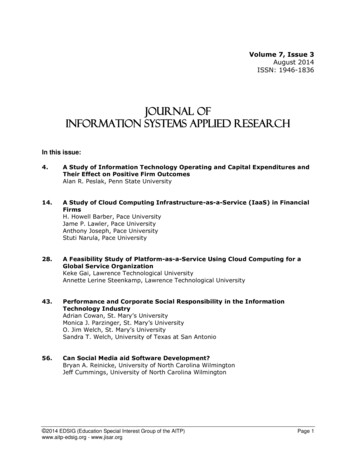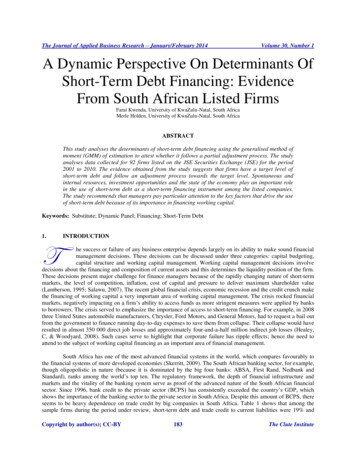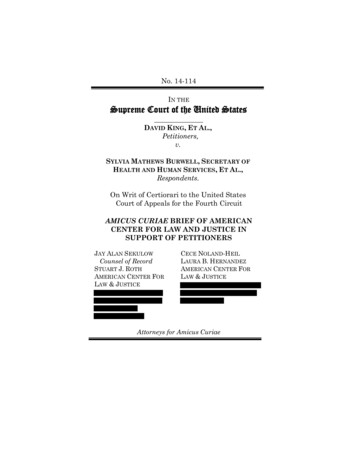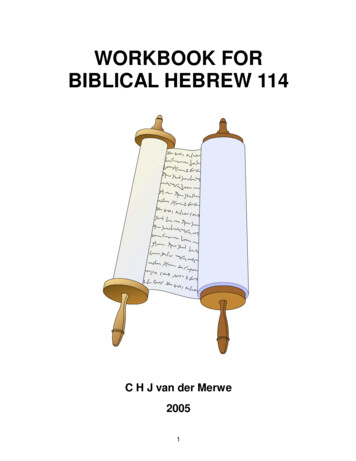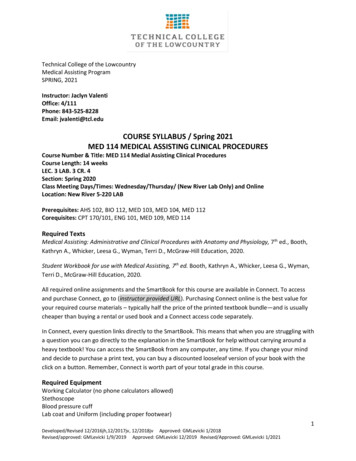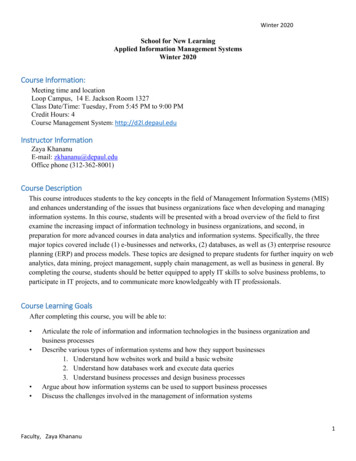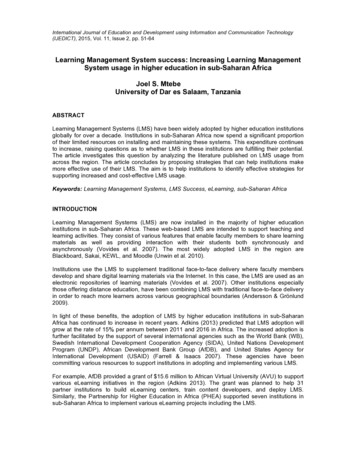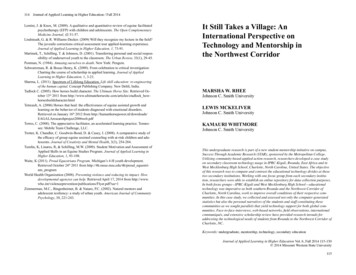
Transcription
114 Journal of Applied Learning in Higher Education / Fall 2014Lentini, J. & Knox, M. (2009). A qualitative and quantitative review of equine facilitatedpsychotherapy (EFP) with children and adolescents. The Open ComplementaryMedicine Journal, (I) 51-57.Lindsteadt, G. & R. Williams-Decker. (2009) Will they recognize my lecture in the field?The juvenile corrections critical assessment tour applied-learning experience.Journal of Applied Learning in Higher Education, 1, 73-91.Martinek, T., Schilling, T. & Johnson, D. (2001). Transferring personal and social responsibility of underserved youth to the classroom. The Urban Review, 33(1), 29-45.Postman, N. (1984). Amusing ourselves to death. New York: Penguin.Schwartzman, R. & Bouas Henry, K. (2009). From celebration to critical investigation:Charting the course of scholarship in applied learning. Journal of AppliedLearning in Higher Education, 1, 3-23.Sharma, L. (2011). Spectrum of Lifelong Education. Life skill education: re-engineeringof the human capital. Concept Publishing Company. New Dehli, India.Tadlock C. (2005). How horses build character. The Ultimate Horse Site. Retrieved October 13th 2011 from http://www.ultimatehorsesite.com/articles/ctadlock howhorsesbuildcharacter.htmlTetreault, A. (2006) Horses that heal: the effectiveness of equine assisted growth andlearning on the behavior of students diagnosed with emotional disorders.Retrieved on January 16th 2012 from project2006web.pdfTorres, C. (2008). The appreciative facilitator, an accelerated learning practice. Tennessee: Mobile Team Challenge, LLC.Trotter, K. Chandler, C. Goodwin-Bond, D. & Casey, J. (2008). A comparative study ofthe efficacy of group equine assisted counseling with at-risk children and adolescents. Journal of Creativity and Mental Health, 3(3), 254-284.Tumlin, K, Linares, R, & Schilling, M.W. (2009). Student Motivation and Assessment ofApplied Skills in an Equine Studies Program. Journal of Applied Learning inHigher Education, 1, 93-108.Waite, K (2011). Proud Equestrians Program. Michigan’s 4-H youth development.Retrieved October 24th 2011 from http://4h.msue.msu.edu/4h/proud equestrians programWorld Health Organization (2008). Preventing violence and reducing its impact. Howdevelopmental agencies can help. Retrieved April 17, 2014 from /Flyer.pdf?ua 1Zimmerman, M.C., Bingenheimer, B. & Nataro, P.C. (2002). Natural mentors andadolescent resiliency: a study of urban youth. American Journal of CommunityPsychology, 30, 221-243.It Still Takes a Village: AnInternational Perspective onTechnology and Mentorship inthe Northwest CorridorMARSHA W. RHEEJohnson C. Smith UniversityLEWIS MCKELIVERJohnson C. Smith UniversityKAMAURI WHITMOREJohnson C. Smith UniversityThis undergraduate research is part of a new student-mentorship initiative on campus,Success Through Academic Research (STAR), sponsored by the Metropolitan College.Utilizing community-based applied action research, researchers developed a case studyon secondary classroom technology usage in IPRC-Kigali, Rwanda, East Africa and inWest Mecklenburg High School, Charlotte, North Carolina, United States. The objectiveof this research was to compare and contrast the educational technology divides at thesetwo secondary institutions. Working with one focus group from each secondary institution, researchers were able to establish an online repository for data collection purposes.In both focus groups—IPRC-Kigali and West Mecklenburg High School—educationaltechnology was imperative as both southern Rwanda and the Northwest Corridor ofCharlotte, North Carolina, work to improve overall conditions of their respective communities. In this case study, we collected and assessed not only the computer-generatedstatistics but also the personal narratives of the students and staff constituting thesecommunities as we sought parallels that yield technology support for both global communities. Face-to-face-interviews, web-based networks, field observations, internationalcommuniqués, and extensive scholarship review have provided research inroads foraddressing the technological needs of students from Rwanda to the Northwest Corridor ofCharlotte, NC.Keywords: undergraduate, mentorship, technology, secondary educationJournal of Applied Learning in Higher Education Vol. 6, Fall 2014 115-130 2014 Missouri Western State University115
116 Journal of Applied Learning in Higher Education / Fall 2014In a recent CUR study (2013), researchers and student mentees shared the following:Time spent as an undergraduate is formative and novel; getting a young researcher involved in the research communitybeyond the student’s specific project can inspire and dramatically encourage students. A mentor can suggest that studentstravel to conferences in different cities or countries, help themconstruct research posters, or use other institutional contacts tohelp the students find summer research opportunities. (“FiveEffective Strategies for Mentoring Undergraduates: Students’Perspectives,” p. 13)This undergraduate research is the next phase of the research mentor’s initial field research in the Northwest Corridor of Charlotte and inthe African countries of Rwanda and Nigeria Success Through Academic Research (STAR), sponsored by the Metropolitan College, is thehighlight of a new student-mentorship initiative on Johnson C. SmithUniversity’s campus. In a 2013 study, academicians Walker & Davenport observed:Thus, while students enrolled in liberal studies courses atJohnson C. Smith University have traditionally explored diversity via textbooks and required university lyceums, this projectallowed students to develop their own study samples, toengage critical scholarship, and to produce significant researchfindings for the university and the communities surroundingthe university. Such professional practice affords incomingfreshmen a tangible, direct interaction with Charlotteans thatno textbook or classroom lecture can provide and promotesmeritorious academic scholarship during their first-year freshman experience. (“Corridor to Charlotte: JCSU as the CulturalBridge to Domestic and International Awareness”)AUTHOR NOTE: Dr. Marsha Walker Rhee is an associate professor of Englishat Johnson C. Smith University, Charlotte, North Carolina. She currentlyserves as a faculty mentor for students enrolled in the STAR research programat JCSU. A noted public speaker and executive director of Collegiate Sisters forAction, Inc., her research interests are the convergences of literature and science, African-American studies, and religion. She is the corresponding authorand may be reached at mwalker@jcsu.edu.Lewis McKeliver is a junior computer engineering major and a STAR researchmentee at Johnson C. Smith University.Kamauri Whitmore is a sophomore communications major and a STAR research mentee at Johnson C. Smith University.This research was supported by a grant from the Metropolitan College, Success Through Academic Research Mentorship Initiative, at Johnson C. SmithUniversity.Rhee, McKeliver, Whitmore / IT STILL TAKES A VILLAGE 117Utilizing community-based applied action research, the researchmentor-mentee team is currently developing a case study on secondaryclassroom technology usage at IPRC-Kigali, Rwanda, East Africa andin West Mecklenburg High School, Charlotte, North Carolina, UnitedStates.The overarching aim of STAR was to identify faculty eager andwilling to engage ten Metropolitan College freshmen in rigorous academic research. In order to facilitate this opportunity, STAR administrators requested faculty to draft a three-page sketch outlining their currentresearch focus and the proposed research budget not exceeding 500.Based on the submission of this sketch, or proposal, and the subsequentpresentation thereof, faculty were matched with a select group of highperforming freshman students in February 2013. These faculty-studentmatches formed the base of a nuanced, guided mentor-mentee programon the university campus. Initially, 18 interested students entered thementor-mentee program; their declared academic majors includedaccounting, biology, criminology, political science, chemistry, socialwork, computer science, computer engineering, global studies, andsports management. (Students were selected based on their academicachievements in their first semester of college and their commitmentto engage in meaningful research activities in addition to their secondsemester course workload).Each research mentor-mentee team was required to participatein mentorship training, to provide the mentee meaningful academicresearch engagement and supervision, to prepare the mentee for conference presentation of the research, and to attend a monthly lunch seminar Q & A forum. Researchers (2013) noted, “It is this fundamentalcomfort and connectedness that allow mentoring relationships to evolveinto the most productive, educational, and constructive interactions inthe research environment” (Pita, Ramirez, Joacin, Prentice & Clarke,p.11). Objectives included faculty mentors assisting research menteesin the development and refinement of their communication and presentation skills in relation to their research project. Research mentor-mentee teams explored key concepts related to conducting research, withparticular focus on the research question, design, procedures, and methodological approaches. Via weekly team meetings and larger discussion groups, research mentor-mentee teams had ample opportunities toreview team project details at various developing stages. Additionally,research mentees presented and discussed research outcomes in formalcampus seminars in preparation for future academic conferences, suchas the 9th Annual Conference on Applied Learning in Higher Education,at which the authors of this research presented.Research mentees for this community-based applied researchproject had established university majors in computer engineering andcommunications while the research mentor was grounded in English,STEM-related writing, and interdisciplinary studies. Utilizing a projectsyllabus and projected timeline, the research mentor-mentee team wasable to tailor overall project details to encompass both humanities andSTEM interests of the team.
118 Journal of Applied Learning in Higher Education / Fall 2014The project syllabus and timeline included a triad of research,discussion, and writing to fulfill STAR objectives. The research mentorreviewed thoroughly the research expectations for the mentees, providing each with a detailed syllabus and project stage completion dates.After two weeks of introductory academic research skills and university facilities prep—including library and applied research lab—theresearch mentor doled out assignments for project completion based onthe skill sets and interests of the two mentees. Each week, mentees metwith mentor to discuss assignment completion, literature review, andsucceeding steps. Mentees were required to maintain research logs andto submit weekly progress reports to STAR administrators.The official launch of the project commenced with an officialcommuniqué with IPRC-Kigali, Rwanda, and West Mecklenburg HighSchool, Charlotte in the spring of 2013. Both secondary schools agreedto provide the necessary assistance for the successful completion ofthe research case study in which the research mentor-mentee teamcompared and contrasted a number of factors that contributed to the enhanced focus on varied educational technologies for both focus groups.The Soul of the Northwest Corridor Initiative was a 2012 university-sponsored survey conducted to assess the area in which Johnson C.Smith University resides. The campus is close to a growing and vibrantuptown Charlotte and is situated in the heart of the northwest corridorof Charlotte, an area undergoing major upheaval and revitalization asmore professional establishments and middle- to upper-income familiesseek out resources closer to uptown Charlotte, North Carolina. Theuniversity, touting itself as “employing a leading-edge methodology as one component in its community-planning process,” has sought toplay the central leadership role in the revitalization efforts along theNorthwest Corridor. Given the university’s historical mandate andreputation as an outstanding institution of higher education within theNorthwest Corridor, the university has made education technology oneof its key emphases at local grade schools occupying the same area.Of particular interest has been West Mecklenburg High School withits Project L.I.F.T. grant designed to retain high school-aged AfricanAmerican males via technology in and outside the routine classroomsetting (http://www.projectliftcharlotte.org/). The university’s investment in educational technology along the Northwest Corridor providesnewer inroads to drastically improving both education and technologyin the Northwest Corridor long term.Similarly, IPRC-Kigali is a newer combined technology-drivenhigh school established in the capital city of Kigali, Rwanda, East Africa, to provide hands-on educational technology for students anxiousto compete in increasingly global education and employment markets.Studies of government-sponsored schools like IPRC-Kigali expressed,“ICT [information and communication technology] has become an important tool for teaching and learning and has therefore attracted a greatdeal of investments in the African countries” (Mukama & Andersson,2008, p. 158).Rhee, McKeliver, Whitmore / IT STILL TAKES A VILLAGE 119Therefore, in this case study, the research mentor-mentee teamcollected and assessed the personal narratives of the students and staffconstituting these communities as they seek parallels that yield technology support for both global communities.LITERATURE REVIEWA review of more recent publications regarding both communities—West Mecklenburg High School and IPRC-Kigali—substantiates the fruitfulness of such a dynamic undertaking and internationalpartnership between the groups. The social variables of gender, age,education, economics, cultural traditions, and religion cut across bothsouthern Rwanda and the Northwest Corridor of Charlotte as bothcommunities seek to revitalize mid-21st century. In the June 17, 2012,edition of The Charlotte Observer, in an article titled “Northwest Corridor Revival Needs Great Expectations,” journalist Ron Stodghill noted,“Counterbalancing the corridor’s rich cultural landscape of vibrantchurches, historic neighborhoods, and plethora of small businesses is anentrenched culture of generational afflictions: joblessness, high crime,absentee fathers, poor health, and so on.” Similarly, communities suchas Rivers and Imo States, Nigeria, hold narratives that speak to richheritage overshadowed by poverty and crime. In a 2001 country synthesis report “Nigeria: Voice of the Poor,” field researchers observed:Since a key finding is that poverty is linked to the inability ofindividuals and households to reciprocate and support otherpeople, to build and use social capital within the communityand the wider environment, the role of local level institutionsin providing this opportunity to maintain reciprocity is crucialfor the poor to be able to keep a sense of dignity in their lives.According to a 2007 report from educational researchers Mukamaand Andersson, “most schools in Rwanda, especially those in theremote countryside, do not have electricity let alone computers andtelephone lines” (p. 157).As both the Northwest Corridor of Charlotte and southern Rwandawork to improve overall conditions of their respective communities, itbecomes imperative to bring education technology to the foreground.While more quantitative studies such as The Soul of the Northwest Corridor Initiative (2012) and the mixed array of government documentson the status of education in southern Rwanda are highly significant,these works do not chronicle the lives of individuals and subgroupswithin these communities.The Rwandan government has invested much in technology-basededucation over the past few years as part of its strategic plan, knownas Vision 20/20, which aims to see Rwanda become a middle-incomenation by the year 2020 (Mukama, 2009, p. 539). According to educational researcher E. Mukama (2009):
120 Journal of Applied Learning in Higher Education / Fall 2014The implementation of information and communication technology (ICT) in Rwanda as a development policy is expectedto be realized in the course of four five-year rolling NationalInformation and Communication Infrastructure (NICI) plansextended over the 20-year span of Rwanda’s Vision 2020,which started in 2001. (p. 539)The country’s president has taken the leadership role on advancements in education as the country pushes its 20/20 agenda. Not unlikethe efforts to revitalize the Northwest Corridor of Charlotte, PresidentKigame and others are working tirelessly to ensure the stability andgrowth of their respective home communities. Technology and enterprise founder John Vrakas (2012) stated, “Under Kigame’s leadership,Rwanda is evaluating its own needs, setting its own priorities, andavoiding the prescriptive reform regimes of Western donors” (“FromGenocide to 3G: Innovations in Rwanda, p.85).In fact, in a recent ComputerWorld article brief, Dan Nystedt (2007)highlighted the excitement of rapid technological advancements in theEast African region: “The partnerships with the organizations are partof an effort by Google to expand the computing services available indeveloping countries ” (“Google to Provide Apps To Groups In Africa,” p. 14). To this end, compulsory education was recently increasedto 12 years (Mukama & Andersson, 2008, p.156). In 2009, a government decision changed the medium of instruction from French to English for all students above the third year of primary school. The abruptshift has created huge challenges for both students and teachers (KigaliEducation Advisor/Information Resource Centre). Such challenges areevidenced by researchers Mukama & Andersson:ICT incorporation in Rwandan schools, as reported by theparticipants, is a new phenomenon that the whole school community is trying to cope with. Seemingly, many efforts arebeing made in terms of establishing ICT infrastructures, andtraining teachers, students, and outsiders. (Mukama & Andersson, p.163)Regardless of the challenges to enhance technology education forall learners in Rwanda, “programs like e-Soko are heralded by technooptimists as proof that mobile technology can make major strides inuplifting the world’s poor” (Vrakas, 2012, p. 84). The e-Soko projectgives farmers tools to quickly assess the market values of their products. In a report by Vrakas (2012), he invariably stated:Their confidence is bolstered by the devices’ rapid spread,which itself seems like a force of nature. Mobile phone penetration in Rwanda grew from less than 1 percent in 2005 to27 percent in 2010, with three mobile operators competingfor the local market. Rwanda’s rapid technology adoption,unfortunately, is an exception among developing countries.Rhee, McKeliver, Whitmore / IT STILL TAKES A VILLAGE 121Many developing nations have struggles to scale up effectivegovernment-backed programs that tap into technology’s promise. Often, these countries lack the capacity for innovation andgrow programs slowly, if at all. (p.84)Mukama & Andersson are convinced that “as technologies continue to develop, they change human interaction and actions. Throughthis, the students’ ways of learning are also modified in line with whatis regarded as relevant forms of learning in educational institutions”(p.157). Communities like the IPRC-Kigali, Rwanda and the Northwest Corridor of Charlotte are also convinced of the purposefulness ofupgrading educational technologies in order to thrive in the 21st century.STAR RESEARCH CASE STUDYThe objective of this research was to compare and contras
and may be reached at mwalker@jcsu.edu. Lewis McKeliver is a junior computer engineering major and a STAR research mentee at Johnson C. Smith University. Kamauri Whitmore is a sophomore communications major and a STAR re-search mentee at Johnson C. Smith University. This research was supported by a grant from the Metropolitan College, Suc-
